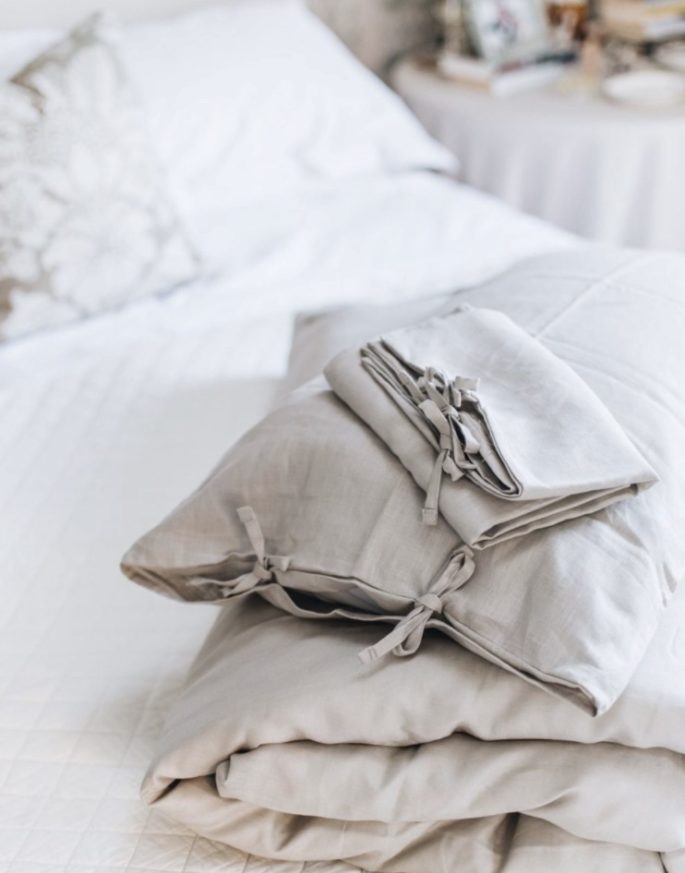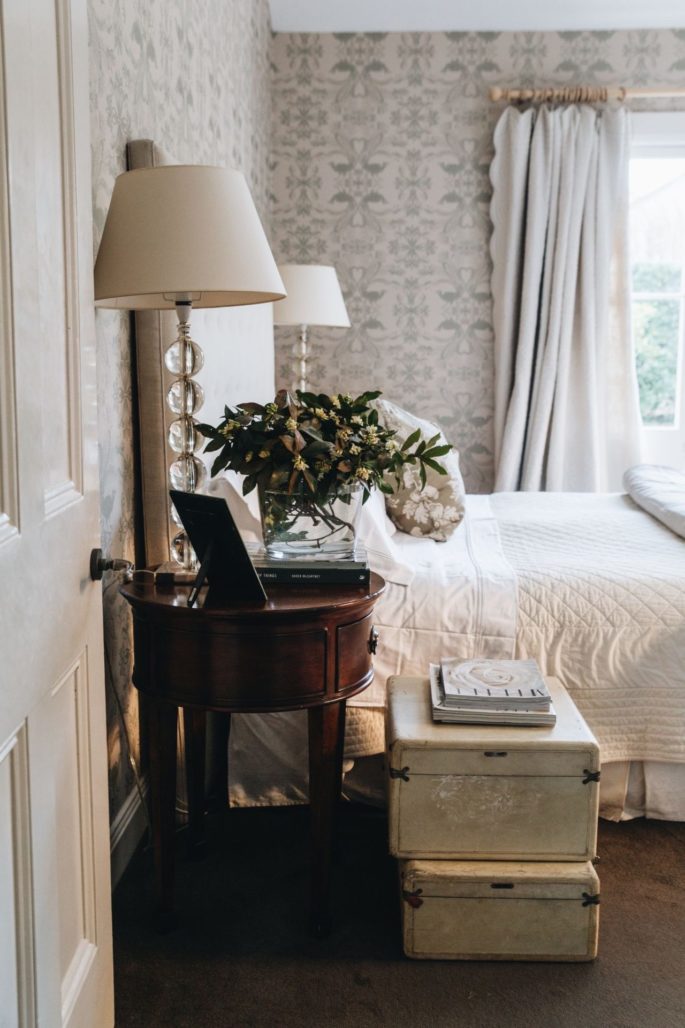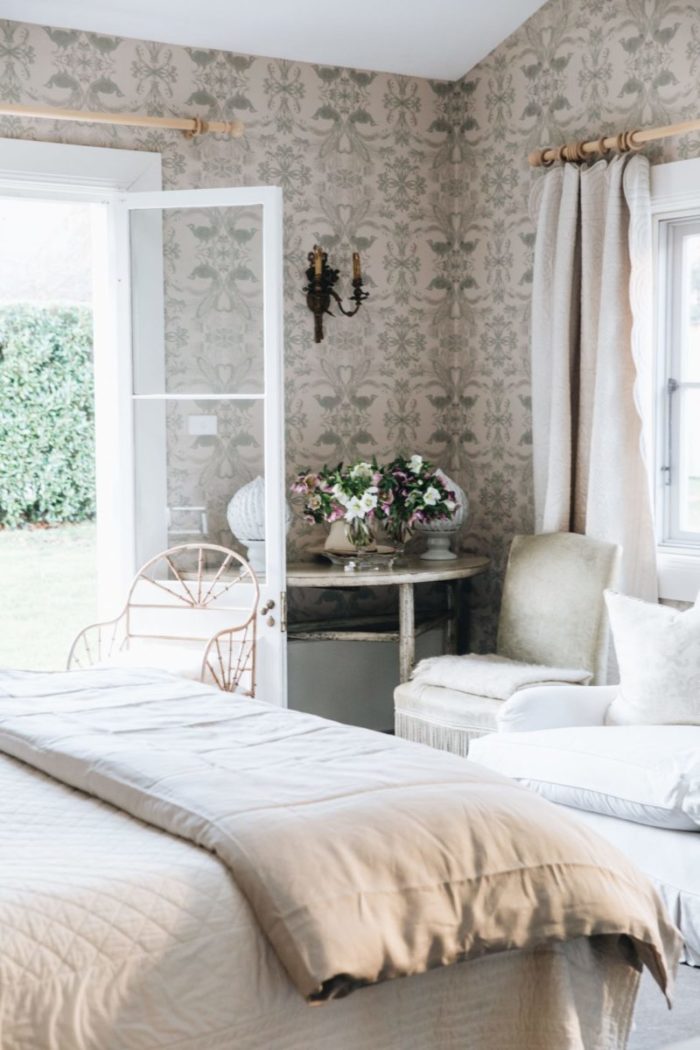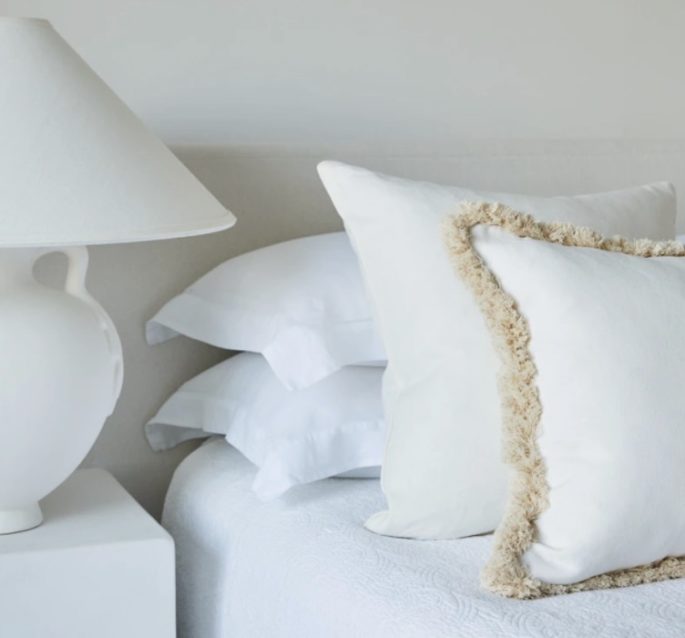The bedroom is where you spend a third of your life. It sets your mood at the start and end of every day, so turn into a haven. Read more, ‘How Posh Is Your Bedroom.’
It has to be beautiful and uncluttered – it’s your most powerful ally in pursuit of wellbeing, happiness, and health.
Limit the Distractions
A bedroom doesn’t need much, just a bed with a proper bedhead, a comfortable chair, bedside tables and lamps, and enough storage. In this part of the house, simplicity is the most fitting.

Melissa Penfold’s bedroom in her Country House.
Plan the Furniture
When it comes to the bed, position it with care – giving it pride of place in the room, most likely with the bedhead positioned against one wall and paths for walking on both sides. Get the height right. Beds that are less than 60 centimetres off the ground make a room look like student digs. Read more, ‘How To Decorate a Bedroom.’
Move up in the world – up to 76 centimetres off the ground –
and you’ll elevate the entire room.
The aim is to have it facing something appealing, which could be as simple as a painting on the wall, or if the architecture allows a window. Never place the bed facing a door – it’s similar to sitting with your back facing the door; so aim to place your bed so that the door is to the right or left of the bedhead. Don’t shove a bed in the corner. They’re impossible to make, and uncomfortable for two people to use. One exception: children’s bunk beds. Because they already have safety rails that usually only allow access from one side, there’s no reason not to have one in a corner. Also, do not put your bedhead against a window, you need to allow air to circulate around the room, not be blocked by furniture.
A note on Symmetry
If there’s space, symmetry demands matching bedsides on both sides for convenience. They could be simple small tabletops, tables with a single drawer for storing essentials, or something larger. It’s hard to go past antique chests of drawers that combines beautiful looks, workmanship and practicality. If you go modern, get substantial pieces with generous drawers.
Many people also like to put a single chair in the corner of a bedroom, not only as a place to rest but also as a landing pad for tossed clothing and personal accessories when you’re in a hurry.
Make It Soft
Because the goal is to create a tranquil room, you should keep your colour palette subtle and tonal. It is probably not the place to use bold colours or graphic wallpaper. Avoid anything that feels aggressive. The more similar each colour, the ‘quieter’ the visual impact.” Read more, ‘Decorating With Colour: A 4-Step Guide.’
Displaying items you love will meet the needs of your soul.
Go for muted, pale background shades in carpets and walls, such as gentle blues, greens and yellows. Consider upholstering bedrooms walls for a literal soft touch. Underfoot, it’s a good idea to add some kind of textile to warm up cold, hard floors – either wall-to-wall carpeting, a large rug that extends underneath the bed or smaller rugs on either side of the bed, and perhaps at the foot of the bed.

Melissa Penfold bedroom in her Country House
Dressing the Bed
A freshly dressed bed is one of the finer things in life, and yet many stumble here. For harmony, work with your overall colour palette. The colours do not have to be identical with the rest of the room, but they do need to be similar in tone. Read more, ‘Pillow Talk: 5 Secrets To Making The Perfect Bed.’
There are many different ways to make a bed, but you need layers, to prevent it from looking like student digs. Do a fitted sheet, a top sheet, and some kind of blanket, (a cotton blanket for summer and a wool blanket for winter. Then, use four standard-sized pillows, usually a combination of down and feather, which you stack. To finish, put a decorative pillow stacked against the standard ones. Then, pop a down duvet with a cover folded at the foot of the bed.
Keep the sheets simple – perhaps hotel-style white linens with a subtle embroidery detail at the edge – and introduce colour with decorative pillow and duvet cover.
Have Fun with your Bedhead
It doesn’t need much fabric. You can really go to town (it’s behind you, so not distracting). Why not paste up some wonderful wallpaper. Add a digitally printed forest, meadow, or have it handpainted in birds and butterflies. Combined with the bedhead treatment, this will provide the design focus for the bedroom. Note, the other walls will need to remain plain for the right effect. Read more, ‘Bedheads 101: Sleep Soundly in Style.’

Melissa Penfold bedroom in her Country House
Consider removing your Ceiling
Most ceilings are cosmetic. Just sheets of plasterboard nailed to the underside of rafters. So give yourself the benefit of increased light and height all in one go.
Control the Light
The ability to control light – both natural and artificial – is important. If you’re sensitive to sunlight when sleeping, you want to have the ability to eliminate it completely. The best way to do so is with a blackout roller shade or a Roman shade with a blackout lining. However, sunlight will still usually leak into the room at the edges of the shade. To block it, add curtains with a blackout lining. Read more, ‘Lighting A Room, Simplified.’
At night, it’s helpful to have layers of lighting. An overhead light allows you to illuminate the whole room quickly but may not do much to set the right mood.
A pair of lamps on bedside tables usually offers a more appealing glow. Many designers use table lamps as well as wall-mounted lamps, either hardwired or plugged into an outlet, on either side of the bed. The table lamps provide an ambient glow, and the wall-mounted lamps provide directional light for reading. You want a super simple table lamp and a really decorative sconce, or vice versa. You don’t want them competing for attention. Every light should be on a dimmer. Good advice for every room of the home.



